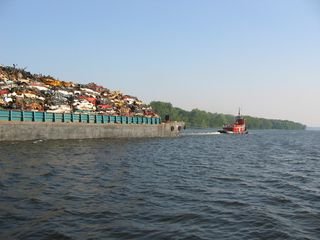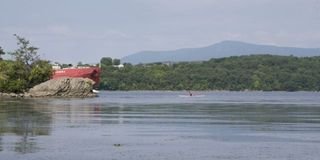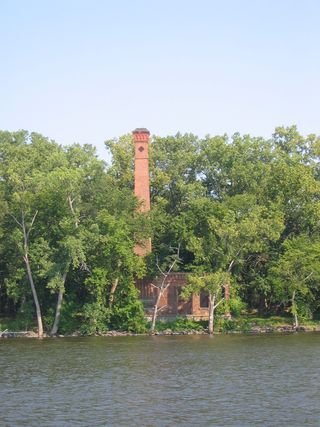Fox and Chickens
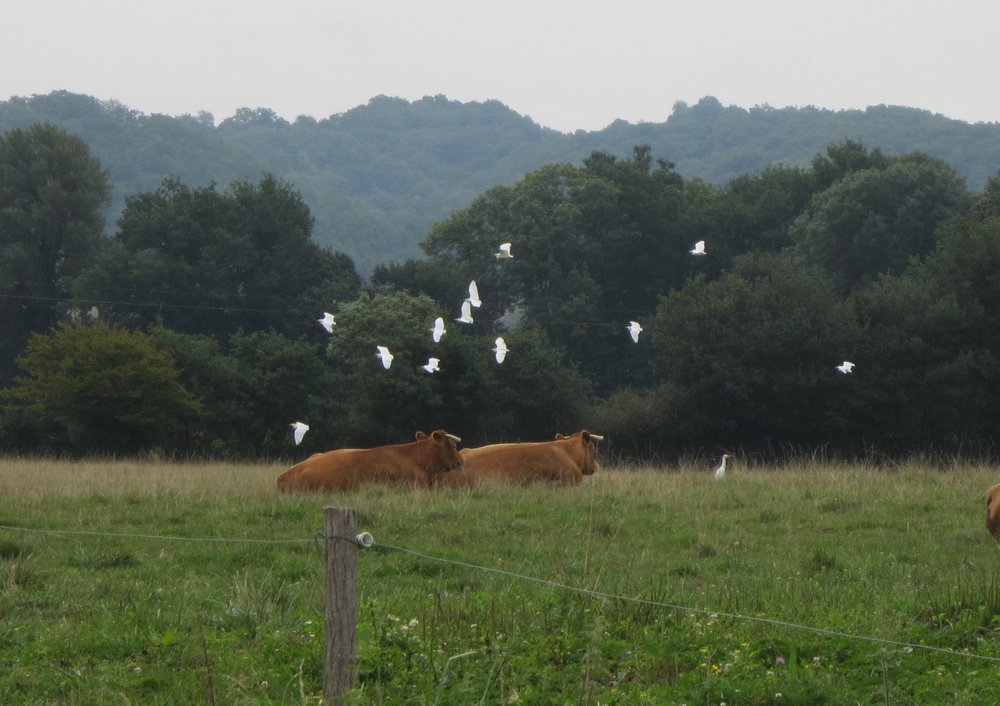
Almost every morning on my walk I see fox. They work the freshly cut fields of hay. I stood and watched one stalk and pounce, all four feet lifting off before it landed on its prey. But so far the chicken-stealing fox is not trappable. He’s sprung the trap twice but has not yet been taken. I’ll continue to quietly side with the fox and publicly hope that Odette’s chickens are safe. Both of these things can be true.

Almost every morning on my walk I see fox. They work the freshly cut fields of hay. I stood and watched one stalk and pounce, all four feet lifting off before it landed on its prey. But so far the chicken-stealing fox is not trappable. He’s sprung the trap twice but has not yet been taken. I’ll continue to quietly side with the fox and publicly hope that Odette’s chickens are safe. Both of these things can be true.
Francis is outdoors a lot and loves the natural world. He’s about an inch shorter than I am, but square, like he was built to move things around. He has a quick smile and like most Gascons, can stand and chat forever. Odette tells him I am looking for birds, and right away he says: we see birds here that we never saw before. He is not the first to say this to me, so I’m beginning to think there’s a real shift in the area. I ask if there is a reason for this. They both agree that it is because there’s less use of pesticides in the fields. Neither say anything about global warming.

Into the Woods, Estampes
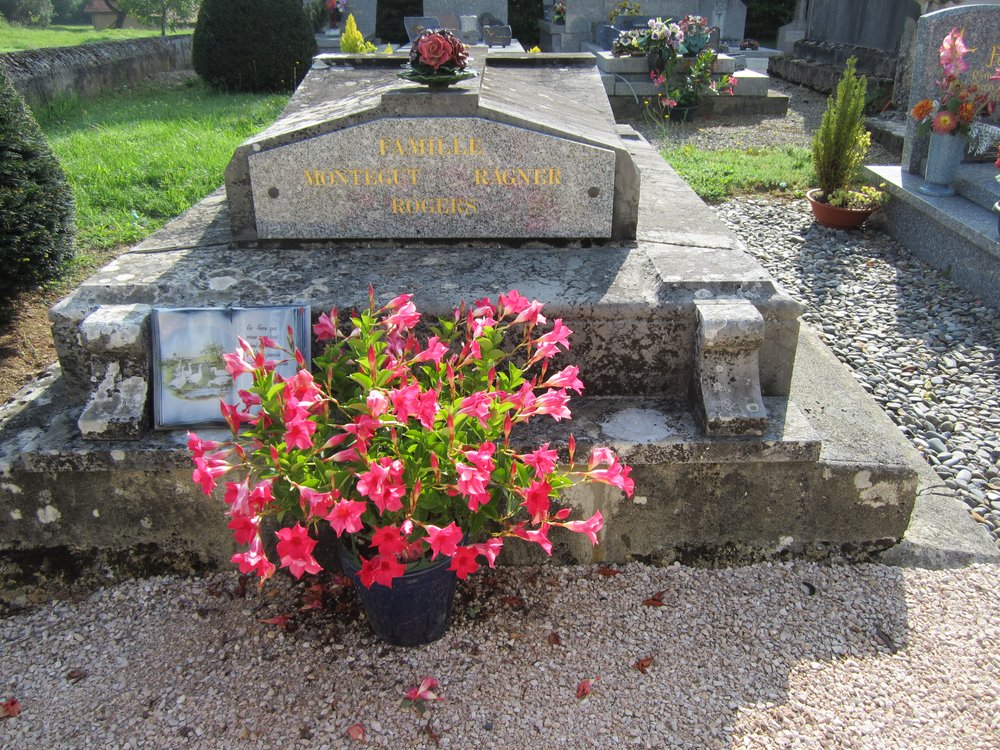
I sit in front of our family tomb and read the names of those inside: Montegut, Ragner, Rogers. Montegut is my great grandfather. Ragner is my grandmother (though not my grandfather, who was buried near Pittsburgh) who grew up in Estampes, then married a Swede born in the States. Rogers is my mother and father, whom we buried in 2005, then 2007. I remember when we added the granite plaque with the name Rogers, the shock of seeing my own name, of realizing this is a place I will rest as well.

I sit in front of our family tomb and read the names of those inside: Montegut, Ragner, Rogers. Montegut is my great grandfather. Ragner is my grandmother (though not my grandfather, who was buried near Pittsburgh) who grew up in Estampes, then married a Swede born in the States. Rogers is my mother and father, whom we buried in 2005, then 2007. I remember when we added the granite plaque with the name Rogers, the shock of seeing my own name, of realizing this is a place I will rest as well.
I leave the cemetery, surprised I am not crying. It’s hard to take stock of when intense grief subsides, but somehow, miraculously it has. Time helps, is what friends told me, though I never believed them. It feels miraculous to be on this side of sadness.
And yet time has not taken the edge off of Odette’s grief when she tells me, as she does every summer, about when her father died. She was fourteen. It was 1943. Her father fell down the stairs, was rushed to the hospital. It was a ruptured intestine, is what she guesses now. Peritonitis. They operated in Tarbes, then brought him home. Five days later he was dead. Like that. Every time she tells the story she folds into tears.

I walked past Elise’s, then past the Arnou’s, whom I still think of as the Parisians though they moved to Estampes in the early 70s. Then I was above the village, looking down on a sweep of fields. In front of me were woods, dense with oak and locust trees. I was, of course, looking for birds. A nuthatch. A brown creeper. I spied a flash of blue and thought the large bird might be a jay. But it was pretty quiet in the woods, and the birds felt skittish compared to the birds at home.
I saw a few cars parked by the side of the dirt road. These were the cars of people hunting mushrooms, cepes, the large boletes, and girolles. In my early twenties I lived in the house in Estampes for a long stretch 
A car approached and the driver came to a halt, turned off the engine and hopped out to shake hands with me. He was older, wearing blue work pants held snug with a belt, and a checked shirt. He was a slender man, his forearms strong and tanned. I did not recognize him, which surprised me.
How is your hunt? he asked.
I explained I was hunting for birds, not mushrooms. And I realized as I said this that a walk without a hunt—birds, mushrooms, flowers—isn’t as fun as one where I am looking for something. The hunt provides direction, small destinations.
What sort of birds, he wanted to know.
Anything, I said, I was from the States, so anything would please me. This was completely true.
Oh, the Americans, he said. You’ve been doing work on your house.
Right.
He told me about the buzzard up the hill. Some farmers don’t like the buzzard, but it’s a good bird, he said.
How was your hunt? I asked.
He said that two weeks ago there was a lot of rain, perfect for mushrooms. They were sure to have a good crop. But then it rained again. And everything went a bit soft. The slugs were having a good time of it, he said. We laughed. Then off he drove and I continued uphill. The woods were calm, the light speckling through the trees. From time to time there was an opening, a small field where farmers grazed their cows. It was humid for the southwest of France, and I could feel the weight of the sun as it rose higher in the sky.
Two men walked toward me. They were both about my age, and carried wicker baskets. The one man looked familiar.
“You are a Ricourt,” I said. It was a good guess as it seems that half of the village are Ricourts, the wealthy baker family.
Oh, he said, and took off his hat, leaning in to kiss me. I could feel the sweat from his cheek cool against my own as we greeted each other.

Estampes

When I arrived in Estampes it was night, so I could not see the fields of corn or sunflower that line the narrow road. I felt the sway of the car as we took tight turns, went up and down through a valley in this area of the southwest of France where the high ridges of the Pyrennes stretch, like fingers, into this farm country. As we drove that final leg into the village—the final minutes before arriving at the house producing a surge of excitement, the excitement of summer, of vacation, of childhood—wild pigs appeared on the road. A mother and seven young, disoriented in the abrupt light of the car. They scattered, regrouped, vanished over the hillside. In all of my years of coming to Estampes—I was first brought here in 1964, aged three—I have never seen wild pigs, sanglier. I thought: it must be good luck to see wild pigs.

When I arrived in Estampes it was night, so I could not see the fields of corn or sunflower that line the narrow road. I felt the sway of the car as we took tight turns, went up and down through a valley in this area of the southwest of France where the high ridges of the Pyrennes stretch, like fingers, into this farm country. As we drove that final leg into the village—the final minutes before arriving at the house producing a surge of excitement, the excitement of summer, of vacation, of childhood—wild pigs appeared on the road. A mother and seven young, disoriented in the abrupt light of the car. They scattered, regrouped, vanished over the hillside. In all of my years of coming to Estampes—I was first brought here in 1964, aged three—I have never seen wild pigs, sanglier. I thought: it must be good luck to see wild pigs.
Estampes is my mother’s village in Gascony. I sleep in the bed she was born in (though there is a new mattress!). When I step through the door, the smell of damp and a touch of something else greets me. It’s the lingering smell of garlic. Or goosefat. The house holds its smells. It also holds its memories of my great great grandfather, who was the school teacher in this village of 120, all farmers. It holds the memory of various old aunts who are names only to me. Madame Castay who lived in a wheel chair, who dragged her basin to the pump every day to get her water. The pump that has since been stolen.
It is easy in this house to let the loss overwhelm me: loss of things—that pump, but also furniture, plates and glasses taken in a robbery in 2003—and, loss of people. My parents. Stanis, our neighbor. All of those aunts, who I did not know, but whose photographs and portraits hang on the walls. They are solid women, often unsmiling. And there are several portraits of the pauvre Fernand, the son of the local doctor who died too young in his 20s.
But on this trip what delights me are the improvements. My sister Becky and her husband Olivier have set the local builders in motion. The outside crumbling wall is now reinforced (the construction is like that of an adobe house of the southwest). And the living room has a new covering that leaves the room bare, gray, but with hopes of a cleaner future.
When I finally tumble into bed what stuns me is the dark and quiet. There’s not a light on anywhere nearby, or the sound of a car. Nothing. It’s almost tomb like. Then, the call of an owl (what sort I can not tell you). That I know for sure is good luck.
In the morning it is the sound of a donkey braying that wakes me. Soon, I’m up to find Odette, our neighbor, with her rabbits and sheep in the barn next door. She looks strong, the lines of her face deeper at 82, but she’s still, as the French say, “lest.” She can get around easily. Odette is a second mother to me, and we share information from the past year as only family might. We laugh, and we cry.
 Then I’m off with Becky to walk the cracked roads, where grass erupts in the middle. She is gathering blackberries for a pie while I’m trying to figure out the birds that wing by overhead. Birding in a new location is always disorienting. At home I know what birds I will find on my morning walk. But the odd thing about birding in France is that the birds are familiar—many the same species. But also not. There are the Tits—Blue, Coal and Great—that look like our chickadee. There are Buzzards that soar overhead like the hawks at home. But then some birds are the same: Doves and Magpies, and some unfortunate species as well, the Starling stealing our figs from the tree, and the House Sparrow.
Then I’m off with Becky to walk the cracked roads, where grass erupts in the middle. She is gathering blackberries for a pie while I’m trying to figure out the birds that wing by overhead. Birding in a new location is always disorienting. At home I know what birds I will find on my morning walk. But the odd thing about birding in France is that the birds are familiar—many the same species. But also not. There are the Tits—Blue, Coal and Great—that look like our chickadee. There are Buzzards that soar overhead like the hawks at home. But then some birds are the same: Doves and Magpies, and some unfortunate species as well, the Starling stealing our figs from the tree, and the House Sparrow.
As we head uphill, I spy a flock of white Cattle Egret standing proud next to a donkey or two. The Egret is new to this area. But so too is the donkey. And it’s not just this one donkey—everyone seems to have gone out and bought a donkey or two. When I was growing up, farmers in Estampes only grazed milk cows.
Every day, I would walk with Odette morning and evening as she took her cows to pasture. We’d meander down the quiet main road in town. On the left, was the Dubourg’s house. Sometimes one of the three kids would come out to shyly say hello—a kiss on both cheeks—or Madame Dubourg herself would emerge, as neat and tidy as her immaculate house itself. On the other side of the road was Mary Louise, a woman who had a daughter by a man who passed through town. She raised the child by herself, gardening to feed her, and taking in laundry to pay the few bills. She would wash our jeans in the river Boues and return them to us, stiff and clean. In these days before telephones were common in the village, we would stop to chat briefly, to share news, exclaim over the weather. But the cows didn’t stop so we’d hustle to catch up with our charges.
In the early days, Odette would leave her mother, Henriette, with a dog to guard the cows. Henriette would sit in the shade of a tree, and when a cow strayed from the field, she’d send the dog to bring it back in. Those were the same years that Odette’s husband Stanis milked the cows by hand. Then came the electric fence, the electric milker. Now those cows are gone. As are the pigs. Odette tends a few sheep as well as her rabbits, and chickens. It is hard not to see loss in this. But now there are donkeys, waking me in the morning.
The rest of the day unfolds like many before it: lunch outside in the courtyard, a nap, some reading, a bike ride into Mielan to buy the paper, some bread, then writing this short missive from Estampes. When I finish writing, I will chase off the starlings and pluck a few figs for myself.
Indian Point
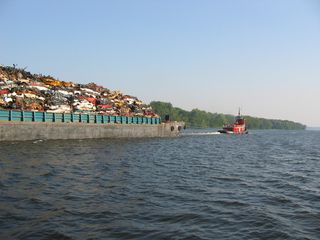
From water level, the towers loomed above me and the entire structure felt imposing. There are layers of red brick buildings smack against the river. Not a window in sight, as if whatever was contained inside shouldn’t be seen, and should not see out. I’d passed some large industry on the river—Trapp Rock up by Poughkeepsie, for instance, but nothing that felt ominous like the Indian Point plant. There are many reasons to protest nuclear power. In my life, the stories of Three Mile Island, Chernobyl and Fukushima are enough to convince anyone this is a risky source of energy. There are many reasons not to want a nuclear power plant so close to a major metropolitan area—9/11 is enough to show how vulnerable we can be. And there are many reasons not to want a nuclear power plant on the Hudson River. The plant rests on a small earthquake fault. And, the plant uses billions of gallons of water t o cool its towers and then spits this warmed water back into the river, altering the ecosystem. In the process, millions of fish are sucked into the plant and killed. But I had not thought about any of this with much care until I stroked past the plant low in my boat.

One spring, I loaded up my kayak with sleeping bag and food and pointed south on the Hudson River. I was traveling with a former student, Emmet, and we intended to take a few days, camping on islands and on the banks of the river, to make our way from my village of Tivoli to Manhattan (I write about this adventure in my upcoming book, MY REACH). This is the freedom of a river, to head out and see what you can see. And I did see many marvelous things on my journey, and lots that I wish I had not seen. Day four I passed the Indian Point nuclear power plant. Instinctively, we scooted to the western shore, giving the plant a wide berth.
From water level, the towers loomed above me and the entire structure felt imposing. There are layers of red brick buildings smack against the river. Not a window in sight, as if whatever was contained inside shouldn’t be seen, and should not see out. I’d passed some large industry on the river—Trapp Rock up by Poughkeepsie, for instance, but nothing that felt ominous like the Indian Point plant. There are many reasons to protest nuclear power. In my life, the stories of Three Mile Island, Chernobyl and Fukushima are enough to convince anyone this is a risky source of energy. There are many reasons not to want a nuclear power plant so close to a major metropolitan area—9/11 is enough to show how vulnerable we can be. And there are many reasons not to want a nuclear power plant on the Hudson River. The plant rests on a small earthquake fault. And, the plant uses billions of gallons of water t o cool its towers and then spits this warmed water back into the river, altering the ecosystem. In the process, millions of fish are sucked into the plant and killed. But I had not thought about any of this with much care until I stroked past the plant low in my boat.
Floating in a kayak on a big river I often feel tiny, especially next to tankers or the barges that shove north and south at all times of day and night (in this photo, a tanker is emerging around Magdalen Island--that little dot is me). But my river view is an important perspective, it’s the same view a beaver might have, or a great blue heron wading by the shoreline. In a kayak, there is an intimacy with the water, whether that water is clean or not, the sights beautiful or not. And I did not like being intimate with a nuclear power plant. It took experiencing the chill of Indian Point on a cool rainy spring day to make me care about shutting down the plant.
And so it comes as good news that Governor Cuomo wants to shut down Indian Point and that new legislation will make this possible. This long battle may finally come to an end. According to Times reporters, Entergy, the company that runs the plant, came away from the meetings “alarmed” with the governor’s direct and strong intentions.
Even though I am skeptical that Indian Point will be shut down, I’m going to be naïve and pretend this is true. I have decided to begin my celebration by wondering what happens to a closed nuclear power plant. Will it join the history of closed industry along the river? When I paddle the length of the estuary, I have passed brick towers that are the remains of the icehouses (photo at left) that stored and brought ice to keep Manhattan cool. There are the sheds that were used in brick making just north of Kingston where teenagers now come to skateboard, the clatter of their leaps and landings echoing through the tall, metal-roofed buildings. There are the remains of the cement industry, and an enormous brick building near the water in Germantown that says “Cold Storage.” These ghosts of industry past I find intriguing, often beautiful. I slip onto shore and out of my boat and poke around these structures, wary of broken glass and often taking a brick as a souvenir. Manhattan is built from Hudson Valley cement and brick. In an odd nostalgia, I wish that this industry were still alive, but cement is reduced to three plants near Smith’s Landing, and the brick industry closed for good in 2001. Yet the end of these industries means a cleaner river, a quieter, calmer river for me to paddle on. One hundred years ago, would I have wanted to see the brick industry close?
So in a hundred years will someone paddle past the crumbling towers of Indian Point and wonder about nuclear power? Perhaps there will be a certain nostalgia as she wishes that we still had that plant generating electricity for New York City. Or will she wonder what we ever imagined was good or sane about nuclear energy?
